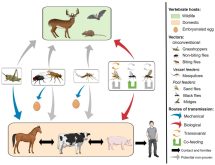June 2023 appears set to be Canada’s first month without a new highly pathogenic avian influenza outbreak in poultry or other domesticated birds since the disease returned to this country in late 2021.
Canada has booked 322 outbreaks in domestic birds in the past 19 months, of which 31 were detected so far in 2023. Of the 31, just one was detected in May, in a commercial barn in Quebec’s Les Maskoutains regional municipality (RCM) on May 6.
As of Friday, the Canadian Food Inspection Agency, which oversees quarantines, culls and disinfections at outbreak sites, counts 35 of the 322 as still “infected,” mainly in backyard non-poultry flocks.
Read Also

Europe, North America face early wave of bird flu cases
An unusually early outbreak of bird flu cases affecting high numbers of wild birds and poultry farms across Europe and North America is raising concerns of a repeat of previous crises that led to mass culling and food price spikes.
Of those remaining 35, eight active sites were in commercial poultry: five at Les Maskoutains, one in Quebec’s Rouville RCM, one at Taber, Alta. and one at Chilliwack, B.C. One other still-active site, near Weyburn, Sask., involved “non-commercial” poultry.
While Canada is not yet free of notifiable avian flu, its decline in active cases and absence of new cases can be seen as positive signs amid North America’s months-long run of outbreaks.
Under the World Organization for Animal Health’s Terrestrial Animal Health Code, WOAH member countries should not impose bans on trade of poultry commodities in response to cases of influenza A viruses in birds “other than poultry.”
In all, as of Friday, Canada has had to cull an estimated 7.668 million domestic birds in nine provinces, both poultry and non-poultry, since its 18-month run of avian flu cases began in Newfoundland in December 2021.
That case, at a “non-poultry” farm on the Avalon Peninsula, had marked Canada’s first high-path avian flu outbreak since 2015.
No domestically-acquired human cases of avian influenza strains have been reported in Canada. However, Canada’s run of outbreaks since late 2021 has seen the virus turn up in multiple wild species, including foxes, seals, dolphins, black bears, wild mink, raccoons, porpoises and skunks. The virus was also confirmed in April to have killed one domestic dog at Oshawa, Ont., after it was seen chewing on a wild goose.
Meanwhile, in the U.S., where 836 domestic and backyard flocks in 47 states have had cases since the start of 2022, leading to culls for an estimated 58.79 million domestic birds, no new cases have been confirmed in domestic birds since May 18. — Glacier FarmMedia Network















